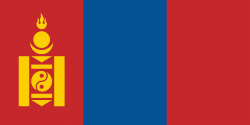Saikhan-Ovoo (Sayhan-Ovoo)
Saikhan-Ovoo (Сайхан-Овоо, Beautiful ovoo) is a sum (district) in central Mongolia. The sum center is on the single perennial river of Dundgovi Province, the Ongi gol. It is the tenth longest river in Mongolia with an overall length of 435 km.
Ongiin Khiid is a notable monastery on the Ongi river about 18 km from Saikhan Ovoo. Formerly one of the largest monasteries in Mongolia, it was founded in 1660 and consisted of two temples complexes on the North and South of the Ongi Gol river. The older southern complex consisted of various administrative buildings as well as 11 temples. The northern complex, built in the 18th century, consisted of 17 temples - among them one of the largest temples in all of Mongolia. The grounds housed also 4 Buddhist universities. It was completely destroyed in 1939 under Khorloogiin Choibalsan, the then president and leader of the Communist Party of Mongolia. Over 200 monks were killed, and many surviving monks were imprisoned or forced to join the Communist controlled army. A large number of ruins including a tall stupa can be seen on the river and on the surrounding hills. In the 1990s, it was decided to rebuild the monastery. The first temple was inaugurated in 2004. There is a small museum in a ger in front of it. One of the stupas has just been reconstructed as well. It has a commemorative plaque indicating the names of the monks who were killed in 1939. At present (2011), 13 monks live in the monastery.
Ongiin Khiid is a notable monastery on the Ongi river about 18 km from Saikhan Ovoo. Formerly one of the largest monasteries in Mongolia, it was founded in 1660 and consisted of two temples complexes on the North and South of the Ongi Gol river. The older southern complex consisted of various administrative buildings as well as 11 temples. The northern complex, built in the 18th century, consisted of 17 temples - among them one of the largest temples in all of Mongolia. The grounds housed also 4 Buddhist universities. It was completely destroyed in 1939 under Khorloogiin Choibalsan, the then president and leader of the Communist Party of Mongolia. Over 200 monks were killed, and many surviving monks were imprisoned or forced to join the Communist controlled army. A large number of ruins including a tall stupa can be seen on the river and on the surrounding hills. In the 1990s, it was decided to rebuild the monastery. The first temple was inaugurated in 2004. There is a small museum in a ger in front of it. One of the stupas has just been reconstructed as well. It has a commemorative plaque indicating the names of the monks who were killed in 1939. At present (2011), 13 monks live in the monastery.
Map - Saikhan-Ovoo (Sayhan-Ovoo)
Map
Country - Mongolia
 |
|
| Flag of Mongolia | |
The territory of modern-day Mongolia has been ruled by various nomadic empires, including the Xiongnu, the Xianbei, the Rouran, the First Turkic Khaganate, and others. In 1206, Genghis Khan founded the Mongol Empire, which became the largest contiguous land empire in history. His grandson Kublai Khan conquered China proper and established the Yuan dynasty. After the collapse of the Yuan, the Mongols retreated to Mongolia and resumed their earlier pattern of factional conflict, except during the era of Dayan Khan and Tumen Zasagt Khan. In the 16th century, Tibetan Buddhism spread to Mongolia, being further led by the Manchu-founded Qing dynasty, which absorbed the country in the 17th century. By the early 20th century, almost one-third of the adult male population were Buddhist monks. After the collapse of the Qing dynasty in 1911, Mongolia declared independence, and achieved actual independence from the Republic of China in 1921. Shortly thereafter, the country became a satellite state of the Soviet Union, which had aided its independence from China. In 1924, the Mongolian People's Republic was founded as a socialist state. After the anti-communist revolutions of 1989, Mongolia conducted its own peaceful democratic revolution in early 1990. This led to a multi-party system, a new constitution of 1992, and transition to a market economy.
Currency / Language
| ISO | Currency | Symbol | Significant figures |
|---|---|---|---|
| MNT | Mongolian tögrög | ₮ | 2 |
| ISO | Language |
|---|---|
| MN | Mongolian language |
| RU | Russian language |















